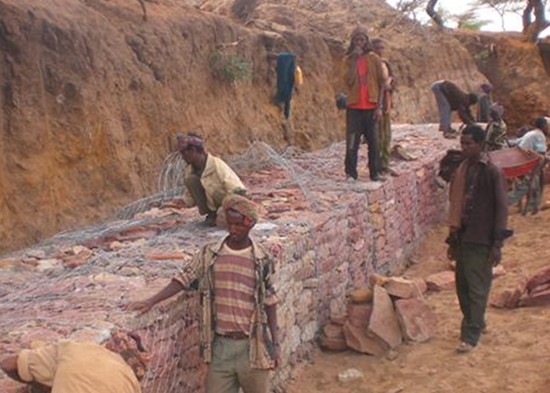“The Columbia Water Center does excellent work exploring imaginative and flexible solutions to critical problems of water resource management in ecologically and often culturally challenging environments. Dr. Lall and his team achieve this with creativity and a wide technical scope, matched by notable efficiency and practicality. In our experience on several projects with them in Ethiopia they have been as effective at conserving administrative resources as in conserving precious water.” – Christina Eisenbeis & Ralph Martin, The Ceil & Michael Pulitzer Foundation
The challenges faced by the residents of Koraro, which is one of the Earth Institutes Millennium Village clusters, are exacerbated by limited infrastructure and geographic isolation. The nearest main road is 54 kilometers away and the village cluster has no means of modern communication.
With funding from the The Ceil and Michael E. Pulitzer Foundation, the Columbia Water Center designed an innovative rainwater harvesting system designed to catch and store water in the landscape. The design includes an interconnected network of five microdams along with an infiltration trench system to recharge underground aquifers. The trench system promises to be a significant innovation over conventional water-storage schemes such as open-air ponds that have low infiltration and are subject to evaporation. Mountains and gullies act as a natural rainwater collection system, from which rainwater is diverted into a man-made level trench. Water then percolates into the soil on the slopes above Koraro. Over time the infiltrated water raises the water table for the area making more water available for plants, irrigation wells and household water use.
To date the CWC taskforce has implemented a pilot project consisting of a 1.2 kilometer, 3 by 3 meter trench, capable of retaining and percolating about 10,800 cubic meters of water per storm.
Results so far have been promising, suggesting that the trench has worked to recharge the groundwater around the village. Numerous other positive impacts include:
- New wells dug above Koraro have reached groundwater at 2.5 to 3 meters; farmers have begun growing vegetables in small plots using these wells
- A small stream that used to dry up near the village now has flowing water for many more months (into February)
- Farmland erosion has been controlled
- A local conflict between farmers over water rights has been alleviated
- Some farmers have begun planting a dry-season crop with the irrigation water from a shallow aquifer that was previously unavailable
Going forward, the team plans to further the development of infiltration infrastructure by:
- Conducting more thorough measurements of groundwater response through monitoring wells and channel flow measurement
- Assessing how groundwater recharge affects agricultural production
- Extending the trench an additional 3 kilometers following an assessment of the performance of existing infrastructure
State of the Planet: Low-cost water management in Ethiopia

